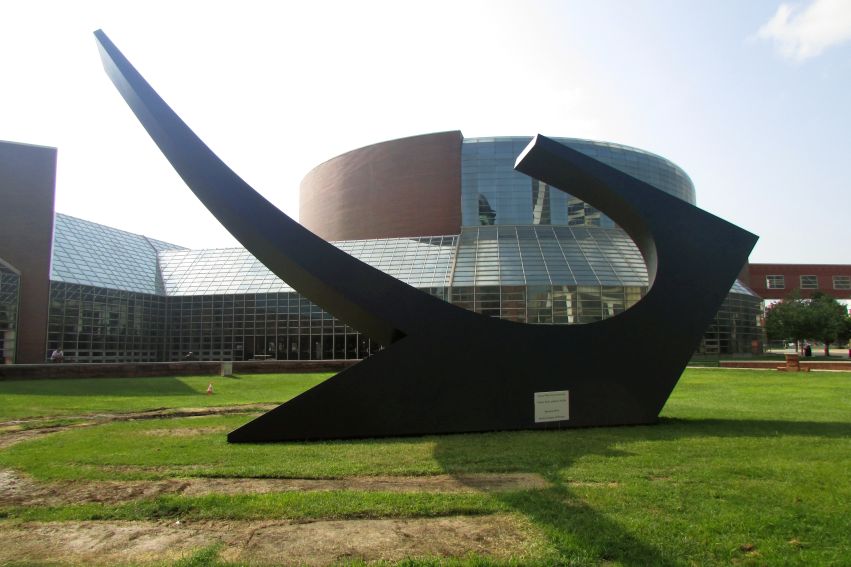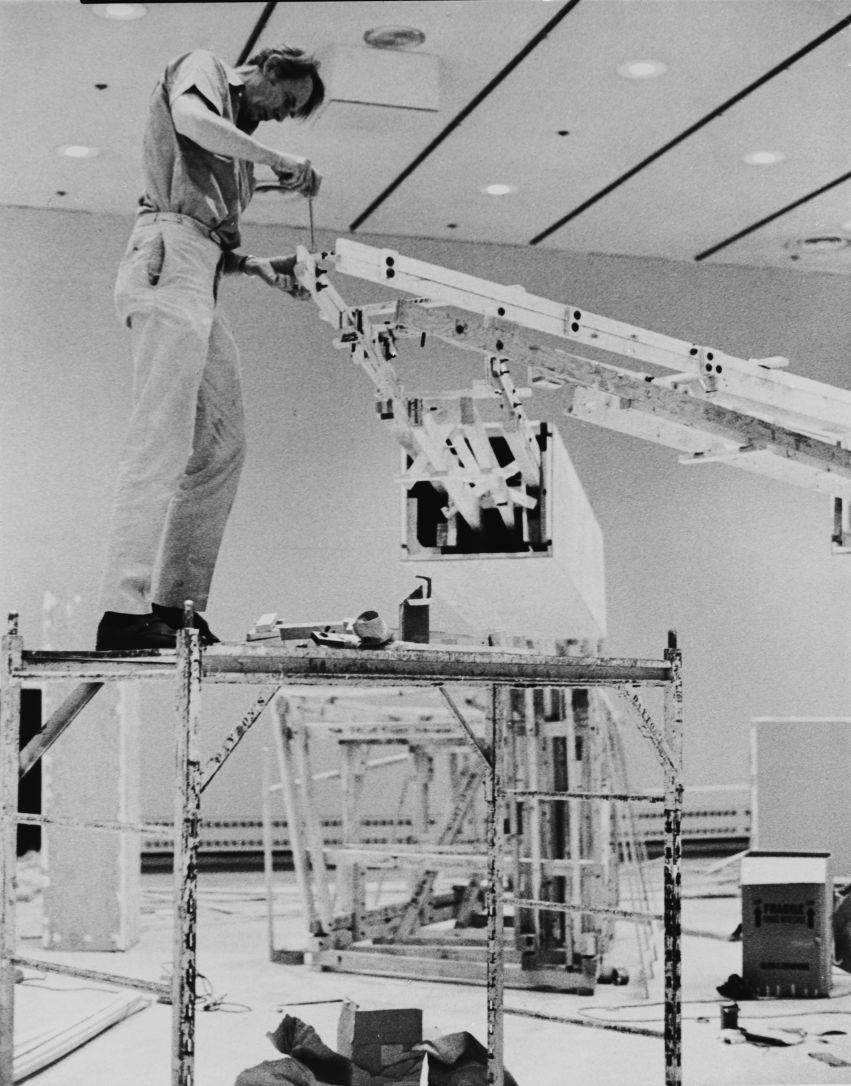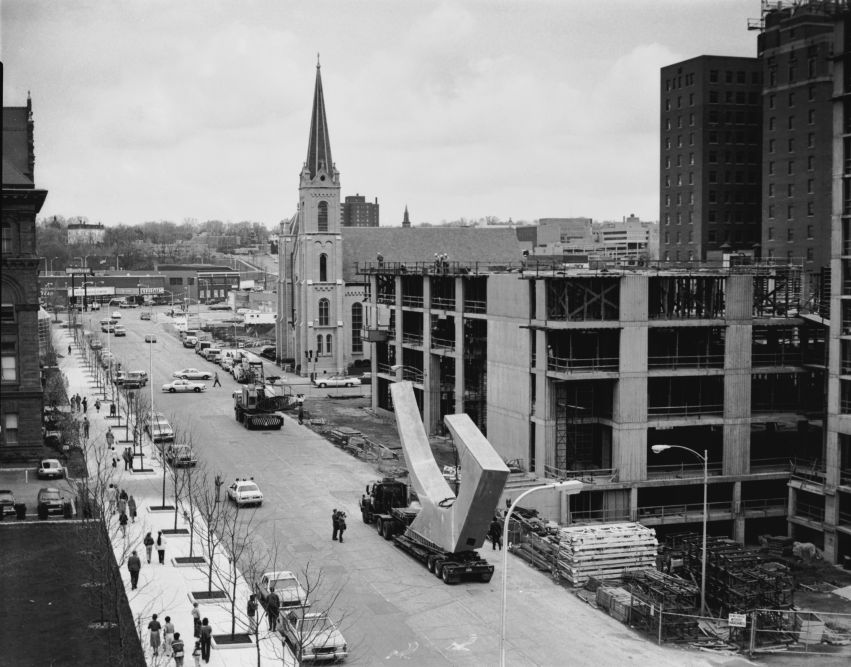
In the spring of 1983, a massive 30,000-pound, welded steel sculpture stretching 50 feet in length and soaring nearly 30 feet in the air, was dedicated to the City of Peoria. Gifted by the Junior League of Peoria, “Sonar Tide” was the work of Ronald Bladen, who was chosen for the project in a national competition. According to former Junior League president Sally Snyder, the desire to bring the work of a world-renowned contemporary sculptor to Peoria spoke of the League’s desire to “show collaboration in the community, but also to bring the arts to the community.”
A Canadian-American artist trained on the west coast, Bladen made his way to New York in the 1950s and became a father of the Minimalist art movement of the 1960s and '70s. Using industrial materials and incorporating an unprecedented monumentality of scale, Minimalist artists reduced form to its basic essence, and though its contrast, attempted to reconnect with the individual and the human form. It is no exaggeration to say that “Sonar Tide” was the first public artwork in Peoria by an artist of such renown and with such generous intent.

Despite the recession that ravaged the community in the 1980s, Peoria was working to rise to a new level of cultural sophistication. Part of the plan involved a civic center designed by Philip Johnson, the most noted living American architect at that time. The sculpture competition would select a featured work of art to complement Johnson’s post-modern masterwork. The Peoria Civic Center, completed in 1982, became the setting for a crown jewel that would announce Peoria’s transformation.
X Marks the Spot
By the 1950s, the center of the art world had witnessed a seismic geographic shift from Paris to New York City as a new set of young, avant-garde superstars embraced the bold frontierism that America symbolized. Combining colossal scale and total abstraction, they brought forth contemplative works that inventively explored an undefined American future. From this group, referred to as the “New York School,” Bladen began as an abstract painter and soon moved into the world of sculpture.
By the time movements like Pop Art and Conceptual Art emerged in the 1960s, Bladen had begun adopting monumentality into his sculptures. His work “X,” installed within the Corcoran Museum in Washington, DC in 1967, upended the world of sculpture. The massive work seemed impossibly placed as its jutting appendages pushed toward the outer reaches of the museum’s architecture. Within the context of the turbulent 1960s, Bladen’s X-like construction—in his signature style of large, reductive black form—suggests a figural image with arms and legs akimbo, either in full self-declaration or in total submission. Given financial constraints, the nearly two-story sculpture was surprisingly built of plywood and painted black.
When applying for the Peoria commission, Bladen took a different approach than some of the other applicants (Richard Serra being one), as he took time to visit Peoria on more than one occasion. His focus turned toward the river, taking note of its twisting shorelines. Sonar fish migration studies were taking place at the time and likely influenced the project’s cryptic title.
Superseding the physical and geographic aspects of Peoria was something he conveyed to me as a Woodruff High School student when Bladen spoke to our art class. I remember the mention of “confidence” and “optimism.” Indeed, he is later quoted that he “immediately saw the curve” when he arrived in Peoria. The sculpture’s soaring, wave-like, French curve launches skyward toward Philip Johnson’s creation and is echoed by a second, more directed curve at the back, slightly conjuring the form of an archer or the tensile energy of a catapult. Its movement is heightened by a tilt to one side like the sail of a clipper ship. To stand beneath it is both alarming and unnerving, and that is the point. “Sonar Tide,” like other great works of public Minimal sculpture, makes you aware of your body and the sublime heft of forces beyond us.
For Bladen, “Sonar Tide” was the culmination of all his public commissions—and arguably his most complicated. Other prominent works, like “Black Lightning,” produced for Seattle just prior to “Sonar Tide” in 1981, similarly explore a cantilevered tension and upward movement, but with more easily produced straight lines and even balance. For comparison, Bladen’s estate has loaned Peoria Riverfront Museum a mid-scale version of “Black Lightning” which can be seen on our sculpture grounds.

A Redefining Restoration
In 2019, Peoria Riverfront Museum contacted the estate in an attempt to bring Bladen’s work to Peoria and foster a greater public appreciation for “Sonar Tide.” Amidst a weary year of Covid, we opened “The Sculpture of Ronald Bladen: Angle Edge Plane,” consisting of more than a dozen working maquettes or models of his large public commissions, working sketches and architectural plans. Included in the exhibition was a drawing of “Sonar Tide” provided by Harvard Art Museums.
Upon discussing potential involvement with the Junior League of Peoria, who was so instrumental in connecting Peoria to Ronald Bladen, we were informed that the League, led by President Andrea Tortora, had resolved to restore the faded and rusted “Sonar Tide” which, if ignored for much longer, teetered on the brink of disastrous disrepair. This effort as well as the preceding exhibition had the generous support of local philanthropists Sharon and John Amdall.
Local sculptors Fisher Stolz and Jaci Willis, both faculty in the Bradley University sculpture department, were engaged to take on the work’s restoration. Armed with their collective experience and a 45-foot lift, the pair tackled the winding array of large scrapes, misplaced graffiti, faded paint and accumulated rust. After more than 300 hours of work in the sweltering heat of summer, the sculpture was reinforced, rebuilt and repainted. When “Sonar Tide” was originally fabricated by the local company Van Buskirk Steel, the saying “Made for Peoria, made in Peoria” was adopted. This more recent coalescence of local talent and dollars has ensured that “restored by Peoria” can now be added to the moniker.

Ultimately, “Sonar Tide” became Bladen’s last and largest public commission as the artist passed away nearly five years after its completion. It is no accident that the miraculous conversion of Peoria’s most important modern artwork has taken place after weathering the worst year in recent history, as Peoria again reaches to redefine itself. The upward energy and surging possibility to which “Sonar Tide” originally alluded speaks once again to the future—just as it did 38 years ago when it first asked Peoria to believe in itself. PM
- Log in to post comments

